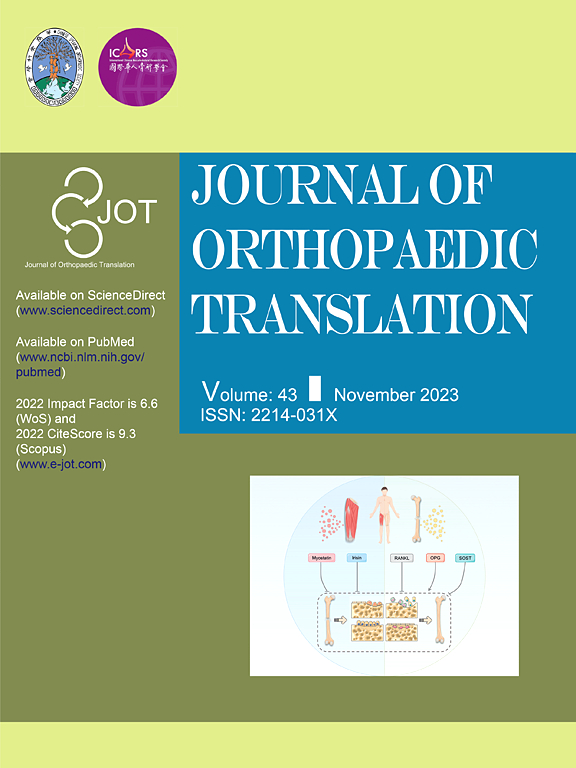神经肌肉电刺激通过AMPK-ULK1-Autophagy轴促进卫星细胞成肌分化,缓解卒中相关性肌少症
IF 5.9
1区 医学
Q1 ORTHOPEDICS
引用次数: 0
摘要
背景中风相关的肌肉减少症可导致肌肉质量减少和肌纤维异常,严重影响肌肉功能。脑卒中相关性肌肉减少症的临床治疗仍需进一步研究和探讨。本研究旨在为脑卒中相关性肌肉减少症患者寻找一种有前景的恢复肌肉功能和促进肌肉再生的治疗方法,为脑卒中相关性肌肉减少症的治疗提供新的理论依据。方法采用永久性大脑中动脉闭塞(pMCAO)大鼠建立脑卒中相关性肌肉减少模型,并采用神经肌肉电刺激(NMES)治疗。模拟体外电刺激(ES)处理,观察NMES对大鼠骨骼肌卫星细胞(MuSCs)肌肉再生的影响。采用Catwalk、H&;E和Masson’s三色染色、免疫荧光、转录组学分析、透射电镜、MuSCs转染、自噬通量检测、实时荧光定量PCR分析、Co-Immunoprecipitation和Western Blot等方法研究NMES在脑卒中相关性肌少症中的作用及其机制。结果NMES治疗后,脑卒中相关肌少症大鼠肌肉量和成肌分化明显增加。NMES组步态更稳定,脚印更整齐,肌肉湿重更高,形态更大,再生肌纤维更多。此外,ES处理在体外诱导大鼠MuSCs成肌分化。转录组学分析还显示,ES处理的细胞中“AMPK信号通路”富集,基因表达上调,表明ES处理可以激活musc中依赖AMPK- ulk1的自噬机制。此外,我们还发现在MuSCs中输注AMPK或ULK1抑制剂、敲低AMPK或ULK1可阻断ES肌管形成的作用。结论nmes不仅能恢复脑卒中相关肌少症大鼠的肌肉功能,还能通过AMPK-ULK1自噬增强成肌活性和肌肉再生。我们的研究为中风相关肌肉减少症的治疗提供了一个有希望的策略。本研究首先证明NMES通过ampk - ulk1 -自噬轴促进MuSCs分化,从而缓解脑卒中相关性肌少症。研究结果揭示了一种新的治疗机制,表明NMES可以恢复中风患者的肌肉功能并增强再生。通过将NMES与基于muscs的疗法相结合,这种方法为临床康复提供了一种有希望的策略,可能会改善中风幸存者的肌肉质量和功能。转化潜力在于其适用于肌少症的无创、低成本治疗,提高患者的生活质量。本文章由计算机程序翻译,如有差异,请以英文原文为准。

Neuromuscular electrical stimulation alleviates stroke-related sarcopenia by promoting satellite cells myogenic differentiation via AMPK-ULK1-Autophagy axis
Background
Stroke-related sarcopenia can result in muscle mass loss and muscle fibers abnormality, significantly affecting muscle function. The clinical management of stroke-related sarcopenia still requires further research and investigation. This study aims to explore a promising therapy to restore muscle function and promote muscle regeneration in stroke-related sarcopenia, providing a new theory for stroke-related sarcopenia treatment.
Methods
Stroke-related sarcopenia rat model was established by using permanent middle cerebral artery occlusion (pMCAO) rat and treated with neuromuscular electrical stimulation (NMES). Electrical stimulation (ES) treatment in vitro was mimicked to test the effect of NMES on muscle regeneration in rat skeletal muscle satellite cells (MuSCs). Catwalk, H&E and Masson's trichrome staining, immunofluorescence, transcriptomic analysis, transmission electron microscopy, MuSCs transfection, autophagy flux detection, quantitative real-time PCR analysis, Co-Immunoprecipitation and Western Blot were used to investigate the role of NMES and its mechanism in stroke-related sarcopenia in vivo.
Results
After NMES treatment, muscle mass and myogenic differentiation were significantly increased in stroke-related sarcopenia rats. The NMES group had more stable gait, neater footprints, higher muscle wet weight, more voluminous morphology and more regenerated muscle fibers. Additionally, ES treatment induced myogenic differentiation in rat MuSCs in vitro. Transcriptomic analysis also showed that “AMPK signaling pathway” was enriched and genes upregulated in ES-treated cells, revealing ES treatment could activate the autophagy in an AMPK-ULK1-dependent mechanism in MuSCs. Besides, it was also founded that infusion of AMPK or ULK1 inhibitor, knockdown of AMPK or ULK1 in MuSCs could block the effect of myotube formation of ES.
Conclusion
NMES not only restores muscle function but also enhances myogenic activity and muscle regeneration via AMPK-ULK1 autophagy in stroke-related sarcopenia rats. Our study provides a promising strategy for the treatment of stroke-related sarcopenia.
The translational potential of this article
This study first demonstrates that NMES alleviates stroke-related sarcopenia by promoting MuSCs differentiation through AMPK-ULK1-autophagy axis. The findings reveal a novel therapeutic mechanism, suggesting that NMES can restore muscle function and enhance regeneration in stroke patients. By combining NMES with MuSCs-based therapies, this approach offers a promising strategy for clinical rehabilitation, potentially improving muscle mass and function in stroke survivors. The translational potential lies in its applicability to non-invasive, cost-effective treatments for sarcopenia, enhancing patients' quality of life.
求助全文
通过发布文献求助,成功后即可免费获取论文全文。
去求助
来源期刊

Journal of Orthopaedic Translation
Medicine-Orthopedics and Sports Medicine
CiteScore
11.80
自引率
13.60%
发文量
91
审稿时长
29 days
期刊介绍:
The Journal of Orthopaedic Translation (JOT) is the official peer-reviewed, open access journal of the Chinese Speaking Orthopaedic Society (CSOS) and the International Chinese Musculoskeletal Research Society (ICMRS). It is published quarterly, in January, April, July and October, by Elsevier.
 求助内容:
求助内容: 应助结果提醒方式:
应助结果提醒方式:


